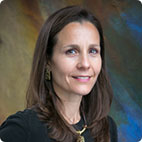Investing in livelihood
These days, PowerPoint slide decks are relied upon to illustrate and guide the business stories we need to deliver to our audiences, yet it is often seen as a worthy effort if you can keep the number of slides to 10 or less. The challenge persists to include enough information to be useful, but not so much that your audiences’ eyes glaze over. So, I challenged myself to create what I call: “The one slide presentation.” It’s my way to counter-intuitively present a minimum of relevant information and narrative I hope will spark questions and conversation, and hopefully a deeper understanding of the focus area, and ideas to activate my audience. The slide includes a heading, a question, a number, and a 55-word story explaining the number. Oh, and two logos, a hashtag, and our brand colors. That is it.
I tried this approach for the first time during a cross-departmental meeting with colleagues at Methodist Healthcare Ministries and was thrilled with the results. What I hoped would happen, did – and more. (Again, we are talking about one slide and five minutes.)
The intention of the one slide presentation was to begin sharing numbers from mining the (non-rigorous evaluation) data from our federally-funded Sí Texas Project (now in year three of five) while telling the story of the data point. I am the program officer for this project, which is designed to implement and evaluate eight models in South Texas on Integrated Behavioral Health (IBH) and Primary Care in Behavioral Health (PCBH). My charge and challenge from the inception of the project has been to demonstrate our sub-grantee’s progress and change – with the unspoken expectation of explaining the barriers to that progress and change.
The question on the slide was: How many people are paid by the grant? The number was 114. The 55-word story was: “People are the power. They deliver services, build the culture, receive the investment of capacity building, sustain what is built, communicate and educate about the services offered through them in organizations, listen to and care for patients, and much more. They also have their own lives to build and sustain. Methodist Healthcare Ministries is investing in livelihood.” I intentionally chose the word “livelihood” because it means income, means of support, living, sustenance, nourishment, daily bread, occupation, and vocation – meanings that resonated with a faith-based organization such as ours. I explained that our project is an economic engine, but it is so much more.
I talked about how, in my lead-up to the meeting, I dropped by the office of a colleague and presented the question, number, and narrative. I told her how I wanted to mine our project’s data to get at numbers such as the average pay for certain positions. She asked how average pay was germane. Her question gave me the opportunity to explain how difficult it has been for most of our sub-grantees to offer competitive salaries to medical providers, especially smaller community-based clinics, resulting in the need to think differently about attraction and retention of personnel. I asked, open-endedly, if there was the possibility of appealing to mission-driven candidates. Our conversation led to how clinics could speak to the meaning of this work and appeal to spouses and families of providers, and how they might join a community and a culture—after all, selecting a job is often a family decision.
The presentation sparked thought-provoking questions and dialogue. One question in particular, about which positions were most difficult to fill, led to a discussion about the health care professional workforce shortage that is pervasive in Texas and across the nation.
I explained how our sub-grantees have been resourceful to fill functions such as nutritionists by shifting nurses or by expanding the role of community health workers, also known as ‘Promotores de Salud.’ I described how difficult it has been for some clinics to attract primary care providers, in one case, waiting several months for one provider’s contract to end at another clinic. In terms of IBH, I talked about the challenge of hiring and retaining behavioral health consultants, a critical function in IBH, especially in rural areas. In fact, it has been difficult to fill many key positions in rural communities, often creating hardship for current staff shifted to serve in outlying communities when they have family and must adjust for longer commutes and transporting their own children to school.
All of this quality content resulted from a question, a number, and a 55-word story.
We live in a complex world and health care is a complex industry. I believe the counterintuitive technique of offering one data point and an interpretation of the data enabled our team to focus on a topic and to dive deeper together into the story of our project and what we are learning.
What are some of the ways your organization is addressing these issues? And, what techniques are you finding effective at communicating these issues to your audiences?









